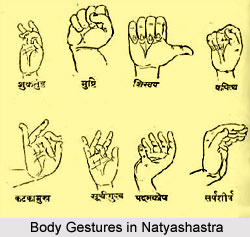 Natyashastra is an ancient form of Indian theatre with details performing arts, encompassing theatre, dance and music. It was written during the period between 200 BC and 200 AD in classical India and is traditionally attributed to the Sage Bharata. It is elaborate of all treatises on dramatic criticism and acting ever written in any language and is regarded as the oldest surviving text on stagecraft in the world. Bharata in his Natyashastra demonstrates every facet of Indian drama whilst covering areas like music, stage-design, make up, dance and virtually every aspect of stagecraft. With its kaleidoscopic approach, with its wider scope Natyashastra has offered a remarkable dimension to growth and development of Indian classical music, Indian classical dances, drama and art. Natyashastra indeed laid the cornerstone of the fine arts in India.
Natyashastra is an ancient form of Indian theatre with details performing arts, encompassing theatre, dance and music. It was written during the period between 200 BC and 200 AD in classical India and is traditionally attributed to the Sage Bharata. It is elaborate of all treatises on dramatic criticism and acting ever written in any language and is regarded as the oldest surviving text on stagecraft in the world. Bharata in his Natyashastra demonstrates every facet of Indian drama whilst covering areas like music, stage-design, make up, dance and virtually every aspect of stagecraft. With its kaleidoscopic approach, with its wider scope Natyashastra has offered a remarkable dimension to growth and development of Indian classical music, Indian classical dances, drama and art. Natyashastra indeed laid the cornerstone of the fine arts in India.Text of Natyashastra
Natyashastra of Bharata Muni contains about five thousand six hundred verses. The commentaries on the Natyashastra are known, dating from the sixth or seventh centuries. The earliest surviving one is the Abhinavabharati by Abhinava Gupta. It was followed by works of writers such as Saradatanaya of twelfth-thirteenth century, Sarngadeva of thirteenth century, and Kallinatha of sixteenth century. However the abhinavabharati is regarded as the most authoritative commentary on Natyashastra as Abhinavagupta provides not only his own illuminating interpretation of the Natyashastra, but wide information about pre-Bharata traditions as well as varied interpretations of the text offered by his predecessors.
Background of Natyashastra
Written in Sanskrit, the vast treatise consists of six thousand sutras. The Natyashastra has been divided into thirty six chapters, sometimes into thirty seven or thirty eight due to further divergence of a chapter or chapters. The background of Natyashastra is framed in a situation where a number of munis approach Bharata to know about the secrets of Natyaveda. The answer to this question comprises the rest of the book. Quite ideally therefore narratives, symbols and dialogues are used in the methodology of Natyashastra.
Contents of Natyashastra
 A mere perusal of the contents of Natyashastra will depict the variety of the topics discussed therein. The principal theme is the dramatic art which concerns the producers of the plays as well as those who compose them, the playwrights. Bharata wanted the plays to be a Drisya Kavya that can be successfully and profitably represented on the stage. The dramatic theory as well as practice has been elaborately dealt with in the text. Hence, manual gestures, facial expressions, poetics, music with all ramifications whether vocal or instrumental, prosody, some points of grammar, costumes, ornaments, setting up of the scenes with appropriate background etc. have been methodically dealt with. The author has treated the subject matter so very analytically as not to hesitate to repeat the things mentioned earlier in order to be more specific.
A mere perusal of the contents of Natyashastra will depict the variety of the topics discussed therein. The principal theme is the dramatic art which concerns the producers of the plays as well as those who compose them, the playwrights. Bharata wanted the plays to be a Drisya Kavya that can be successfully and profitably represented on the stage. The dramatic theory as well as practice has been elaborately dealt with in the text. Hence, manual gestures, facial expressions, poetics, music with all ramifications whether vocal or instrumental, prosody, some points of grammar, costumes, ornaments, setting up of the scenes with appropriate background etc. have been methodically dealt with. The author has treated the subject matter so very analytically as not to hesitate to repeat the things mentioned earlier in order to be more specific.Cultural Projection in Natyashastra
Prakrita and allied native languages are meticulously dealt with by means of examples in the Natyashastra. References have been made to the languages of ancient tribes such as Barbaras, Kiratas, Andhras, Dravidas, Sabaras, Candalar etc. Beautiful verses of very fine literary excellence have been given by way of examples, while dealing with Dhruva songs, metres etc. In many of these verses the innate charm divested of all the artifices and linguistic of the later classical age are found. Rasas, Bhavas, Alankaras etc. are portrayed well. Dance is inseparable from drama and Bharata has done full justice to it. The various Abhinayas mentioned in the text have been portrayed by mural paintings, sculpture, architecture etc. in the temples. Various crafts are brought into play to create a suitable background in the stage in different scenes. Natyashastra gives detailed directions about the dressing material, modes of wearing the garments and jewellery, articles to be used by the different characters in a play in accordance with their social status, profession, the cultural practice etc.
For more check the link below: